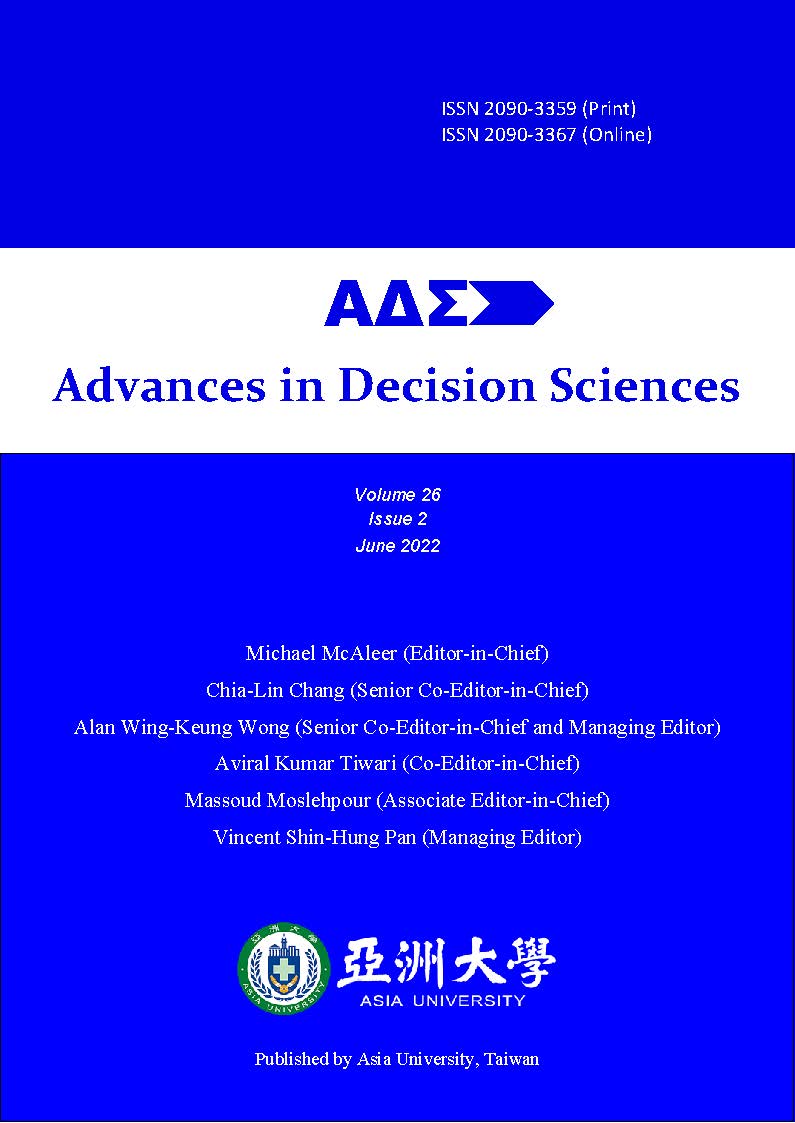Do Exchange Traded Funds in India Have Tracking and Pricing Efficiency?
DOI:
https://doi.org/10.47654/v26y2022i2p1-25Keywords:
Exchange Traded Funds, Tracking Error, Pricing Efficiencies, Arbitrage Opportunity, Authorised Participants, Net Asset ValueAbstract
Purpose: The study investigates tracking and pricing efficiencies of selected exchange-traded funds (ETFs) in India.
Design/methodology/approach: The study applies different methods of determining tracking errors to assess tracking abilities of ETF managers; the average absolute differences, as well as the standard deviation of differences between ETF returns and benchmark returns and standard errors from the regression of ETF, returns against the benchmark. The study further uses Vector Error Correction Model (VECM) to examine the lead lag relationship between Net Asset Values (NAVs) and market prices of ETFs and pricing efficiency.
Findings: ICICI Prudential Sensex ETF exhibits the highest tracking error and Aditya Birla Sun Life Nifty ETF shows the lowest tracking error. NAVs lead their respective market prices indicating huge scope for arbitrage opportunities to authorized participants. Persistence in the deviation between NAVs and market prices is prevalent for a longer period, indicating an inefficient price discovery mechanism of the Indian ETF market. The study confirms market inefficiency in the Indian ETF market.
Originality/value: The existing literature on tracking and pricing efficiencies of ETF is largely with respect to advanced countries. There is limited evidence of such studies in the Indian context. Hence, the study adds to the literature by examining the efficient market hypothesis in the Indian ETF market in terms of tracking and pricing efficiencies.
Practical Implications: The study reveals the presence of inefficient price discovery and the scope for arbitrage. This may be due to low level of trading activity and inefficient arbitrage mechanism in India. Hence, it is the need of the hour that Securities and Exchange Board of India (SEBI) and stock exchanges should take necessary initiatives to improve trading activity in ETFs and thereby achieve market efficiency.
Keywords: Exchange Traded Funds; Tracking Error; Pricing Efficiencies; Arbitrage Opportunity; Authorized Participants; Net Asset Value
JEL Classification: G1, G2, G4
Paper Type: Research Paper
References
Ackert, L. F., & Tian, Y. S. (2000). Arbitrage and valuation in the market for Standard and Poor's Depositary Receipts. Financial Management, 71-87.
Aditya, G., & Desai, R. (2015). Pricing Efficiency and Price Discovery of Indian Equity ETFs. The Journal of Index Investing, 6(3), 67.
Agapova, A. (2011). Conventional mutual index funds versus exchange-traded funds. Journal of Financial Markets, 14(2), 323-343.
Blitz, D., & Huij, J. (2012). Evaluating the performance of global emerging markets equity exchange-traded funds. Emerging Markets Review, 13(2), 149-158.
Broman, M. S. (2016). Liquidity, style investing and excess co-movement of exchange-traded fund returns. Journal of Financial Markets, 30, 27-53.
Chang, C. L., Hu, S. Y., & Yu, S. T. (2014). Recent Developments in Quantitative Finance: An Overview. Annals of Financial Economics, 9(02), 1402002.
Chang, C. L., McAleer, M., & Tansuchat, R. (2012). Modelling long memory volatility in agricultural commodity futures returns. Annals of Financial Economics, 7(02), 1250010.
Charteris, A., Chau, F., Gavriilidis, K., & Kallinterakis, V. (2014). Premiums, discounts and feedback trading: Evidence from emerging markets' ETFs. International Review of Financial Analysis, 35, 80-89.
Charupat, N., & Miu, P. (2013). Recent developments in exchange-traded fund literature: Pricing efficiency, tracking ability, and effects on underlying securities. Managerial Finance, 39(5), 427-443.
Chau, F., Deesomsak, R., & Lau, M. C. (2011). Investor sentiment and feedback trading: Evidence from the exchange-traded fund markets. International Review of Financial Analysis, 20(5), 292-305.
Chu, P. K. K. (2011). Study on the tracking errors and their determinants: evidence from Hong Kong exchange traded funds. Applied Financial Economics, 21(5), 309-315.
Coronado, S., Gupta, R., Hkiri, B., & Rojas, O. (2020). Time-Varying Spillovers between Currency and Stock Markets in the USA: Historical evidence from more than two centuries. Advances in Decision Sciences, 24(4), 1-32.
DeFusco, R. A., Ivanov, S. I., & Karels, G. V. (2011). The exchange traded funds’ pricing deviation: analysis and forecasts. Journal of Economics and Finance, 35(2), 181-197.
Engle, R. F., & Granger, C. W. (1987). Co-integration and error correction: representation, estimation, and testing. Econometrica: journal of the Econometric Society, 251-276.
Franses, P. H. (2020). Measurement Error in a First-order Autoregression. Advances in Decision Sciences, 24(2), 1-14.
Göncü, A., & Akyildirim, E. (2017). Statistical arbitrage in the multi-asset Black–Scholes economy. Annals of Financial Economics, 12(01), 1750004.
Ivanov, S. I. (2013). The influence of ETFs on the price discovery of gold, silver and oil. Journal of Economics and Finance, 37(3), 453-462.
Jares, T. E., & Lavin, A. M. (2004). Japan and Hong Kong exchange-traded funds (ETFs): Discounts, returns, and trading strategies. Journal of Financial Services Research, 25(1), 57-69.
Kudryavtsev, A. (2020). Immediate And Longer-Term Stock Price Dynamics Following Large Stock Price Changes. Annals of Financial Economics, 15(01), 2050002.
Milonas, N. T., & Rompotis, G. G. (2006). Investigating European ETFs: The case of the Swiss exchange traded funds. In Conference of HFAA in Thessaloniki, Greece.
Nargunam, R., & Anuradha, N. (2017). Market efficiency of gold exchange-traded funds in India. Financial Innovation, 3(1), 14.
Nguyen, T. D. T., & Vo, D. H. (2019). The Determinants of Systematic Risk in Vietnam. Advances in Decision Sciences, 23(2), 1-21.
Peltomäki, J. (2017). Beta as a determinant of investor activity in sector exchange-traded funds. The Quarterly Review of Economics and Finance, 65, 137-145.
Petajisto, A. (2017). Inefficiencies in the pricing of exchange-traded funds. Financial Analysts Journal, 73(1), 24-54.
Qadan, M., & Yagil, J. (2012). On the dynamics of tracking indices by exchange traded funds in the presence of high volatility. Managerial Finance, 38(9), 804-832.
Rompotis, G. G. (2010). Does premium impact exchange-traded funds’ returns? Evidence from iShares. Journal of Asset Management, 11(4), 298-308.
Rompotis, G. G. (2014). On leveraged and inverse leveraged exchange traded funds. Aestimatio, (9), 150.
Selim, K. S., Okasha, A., & Ezzat, H. M. (2015). Loss Aversion, Adaptive Beliefs, and Asset Pricing Dynamics. Advances in Decision Sciences, 2015.
Shin, S., & Soydemir, G. (2010). Exchange-traded funds, persistence in tracking errors and information dissemination. Journal of Multinational Financial Management, 20(4-5), 214-234.
Singh, J., & Kaur, P. (2016). Tracking efficiency of exchange traded funds (ETFs) empirical evidence from Indian equity ETFs. Paradigm, 20(2), 176-190.
Sinha, S., & Dutta, M. (2013). Performance analysis of returns of Goldman Sachs gold exchange traded fund. Global Journal of Management and Business Studies, 3(7), 793-800.
So, M. K., Liu, W. K., & Chu, A. M. (2018). Bayesian shrinkage estimation of time-varying covariance matrices in financial time series. Advances in Decision Sciences, 22, 1-35.
Tripathi, V., & Garg, S. (2016). A Cross-Country Analysis of Pricing Efficiency of Exchange Traded Funds. IUP Journal of Applied Finance, 22(3).
Yavas, B. F., & Rezayat, F. (2016). Country ETF returns and volatility spillovers in emerging stock markets, Europe and USA. International Journal of Emerging Markets, 11(3), 419-437.
Yiannaki, S. M. (2015). ETFs performance Europe-a good start or not?. Procedia Economics and Finance, 30, 955-966.

Published
Issue
Section
License
Copyright (c) 2022 Advances in Decision Sciences

This work is licensed under a Creative Commons Attribution-NonCommercial 4.0 International License.







 Scientific and Business World
Scientific and Business World